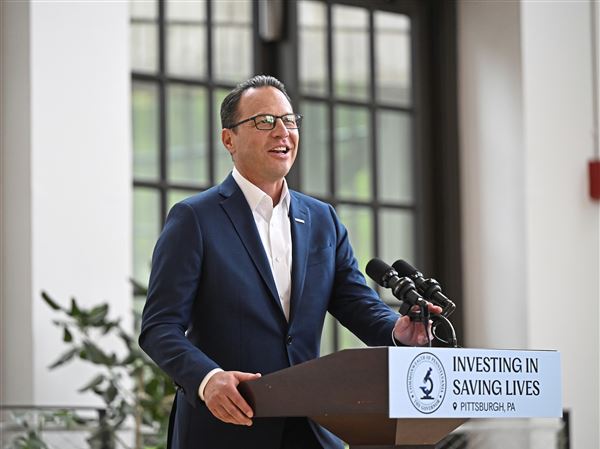
By Annie O'Neill, Post-Gazette
Pittsburgh Post-Gazette
His tongue wagging, the rocker launches into a furious solo on stage. Shouts and cheers emerge from the crowd half-hidden in the smoky and darkened room. Amplified power chords soon bring the song to its riveting conclusion.

VIDEO: This video follows the Cellofourte quartet as its members prepared for and ultimately won the Pittsburgh finals of a worldwide "battle of the bands" competition for unsigned groups at Mr. Smalls in Millvale. The group of four classically trained cellists, Tate Olsen, Ben Munoz, Simon Cummings and Nicole Myers, play rhythmically charged original instrumentals that sound like a mix of Vivaldi baroque and speed metal.
Click image to launch video.
More Tunes
Excerpts from Cellofourte original songs:
 "Trogdor" by Simon Cummings.
"Trogdor" by Simon Cummings.
 "The Dream Within" by Tate Olsen and Ben Munoz.
"The Dream Within" by Tate Olsen and Ben Munoz.
 "Self Destruction" by Munoz.
"Self Destruction" by Munoz.
Links
It would be a typical scene at a concert venue like Mr. Smalls in Millvale, except that all of the musicians are toting cellos. But they rock just the same.
Meet Cellofourte, a local group of four classically trained cellists who are rising fast in a different scene -- the pop world. They don't play the electric version, but traditional wooden cellos, each amplified by a small microphone pickup below the bridge.
Other than among diehard fans, Cellofourte is relatively unknown. Half its members are still in college and the other half just graduated.
But the group took a major step last week toward emerging on the national stage, beating 11 local rock bands in the Pittsburgh finals of a worldwide "battle of the bands" competition for unsigned groups. The next step is Columbus, Ohio, tomorrow for a regional competition and, if it continues its winning ways, possibly on to Germany and a record deal.
Playing a set of rhythmically charged originals -- energetic instrumentals that sounded like a mix of Vivaldi baroque and speed metal -- Cellofourte "wowed the crowd ... with an outstanding set of original ... rock? Classical?" said Bob LaBlah of the Emergenza Music Festival, which held the local rounds of its competition last week. "It was the perfect hybrid of both,'' he wrote on Emergenza's Web site, "and the audience ate it up!"
It's just the latest in a wild ride for the group founded in 2004. Smashing stereotypes is a riff the group repeats everywhere it plays.
"Whenever we finish a few songs our favorite reaction is, 'Wow, I didn't know cellos could do that,'" said Ben Munoz, a junior at Duquesne University and the group's youngest member.
At first, neither did any of the other members: Simon Cummings, a senior at Carnegie Mellon University, and two CMU graduates, Nicole Myers and founder Tate Olsen. Each grew up playing and studying the cello with the thought of someday joining an orchestra or string quartet.
That's still a potential goal for most of them. But in the '90s, things began to change when an all-cello Finnish group called Apocalyptica had a surprise hit with an album of Metallica covers, garnering fans in the classical and metal worlds alike.
"That really opened my eyes," said Mr. Olsen, who heard them as a senior in Fox Chapel High School. He kept that sound in the back of his mind, and later, as a student of Pittsburgh Symphony cellist David Premo at CMU, he gave it a chance.
"I got together with a few of my friends who were all in Dave Premo and Anne Martindale Williams' studio," he recalled. "We just started playing some stuff." Mr. Olsen first wanted to call the group Quatracelli, but learned the name already had been taken several times over.
Much brainstorming led to the double entendre of the musical marking for loud, forte, with a twist to recognize the four players. Only Mr. Olsen and Ms. Myers are left from the original makeup of the group that has played gigs at Club Cafe on the South Side, the 31st Street Pub in the Strip, Shadow Lounge in East Liberty, The Andy Warhol Museum and various local coffee shops.
In the mold of Apocalyptica, at least in repertoire, the cellists started out covering tunes by Evanescence, Staind and, yes, Metallica.
"Most groups like us are derived somewhat from [Apocalyptica] because they did do it first, but where we differ a lot is they have such a distorted sound," said Mr. Munoz. "We feel it defeats the purpose of playing music on cellos if you don't sound like cellos."
Cellofourte, which now plays mostly original music written by its members, is in fact trying to distance itself from other all-cello bands like Rasputina by stressing its adherence to the natural sound of the instruments.
"The thing about other four-cello groups [is that] they immediately go to the effects pedals and distortion," said Mr. Olsen. "We avoid that because we have worked many years to get a good sound out of a cello and why throw that away? And if you are good, you can get all the cello tendencies with the bow. Why resort to processing?"
It is the years of classical training and practice that allow Cellofourte members this route, and half the reason they prevailed last Saturday. "The quartet is well-rehearsed and uber-talented," Mr. LaBlah concluded in his online assessment.
"We have spent our entire classical lives keyed into precision and detail maybe some of the other bands aren't doing," said Mr. Munoz. "It is just how we have been trained."
"I feel like we get a tad bit more respect when we walk in just because we are so different," said Ms. Myers. "It is really interesting actually walking into a smoky bar with 12 other bands getting ready for a show. We are kind of in our little corner with our tuners."
The other bands at last Saturday's competition took note, too. "My drummer gave them the best compliment I heard all day," said Ron Kuhn, bassist for Alive in the Underground. "He leaned over and said, 'Somebody left the door open and let the real musicians in.'''
When Cellofourte took the stage earlier in the day during the general sound check for the bands, "everyone instantly stopped what they were doing and took a look," said Mr. Kuhn. "What was most surprising to me was the applause that they got. It was nobody but the other bands we were going to be in competition with, and everybody yelled and clapped."
The audience later that evening dug it, too. Cellofourte got the highest audience vote and picked up a few more fans.
"I was curious," said Dave Bowser of Butler. "I didn't expect them to rock. And the precision, that's what got me."
Cellofourte may point to its classical training as an advantage, but its members are anything but arrogant about the pop world. They know there are many aspects of performing in clubs that they had to learn. Chief among them is image, something nearly nonexistent in classical music.
"We actually have to think about wardrobe!" said Ms. Myers. "We don't wear tuxedos or black gowns. We wear ripped jeans and tank tops [with] spiked hair."
Mr. Cummings, who actually played in several rock bands growing up, sported a faux Mohawk at Saturday's concert, while Ms. Myers slipped into leather pants. Mr. Munoz, perhaps the member most brimming with rock-star qualities, performed in a tank top with ample curly hair flailing about. All of the members wore black fingernail polish.
Image also is key to performance. "The only thing I told them was to work on their stage presence," said Darren Burgfeld, backstage at Mr. Smalls and an Emergenza area manager coordinating the sprawling competition.
"But they did better later on in the show," he said, referring to the jam session that ended Cellofourte's set, when the cellists started standing up to play intense music. "I love it. It is something fresh and I have seen thousands of bands."
How far can Cellofourte go? Mr. Burgfeld is optimistic. "They have a specific market because of what they do, but they also have a broader market," he said.
"That is one of the main goals of this group," Mr. Munoz said of connecting classical and rock audiences. "We are trying to bring the two cultures together."
Cellofourte performs locally at 6 p.m. Monday at the David L. Lawrence Convention Center as part of Pittsburgh Magazine's Best Restaurants Party.
First Published: June 7, 2007, 9:45 p.m.














